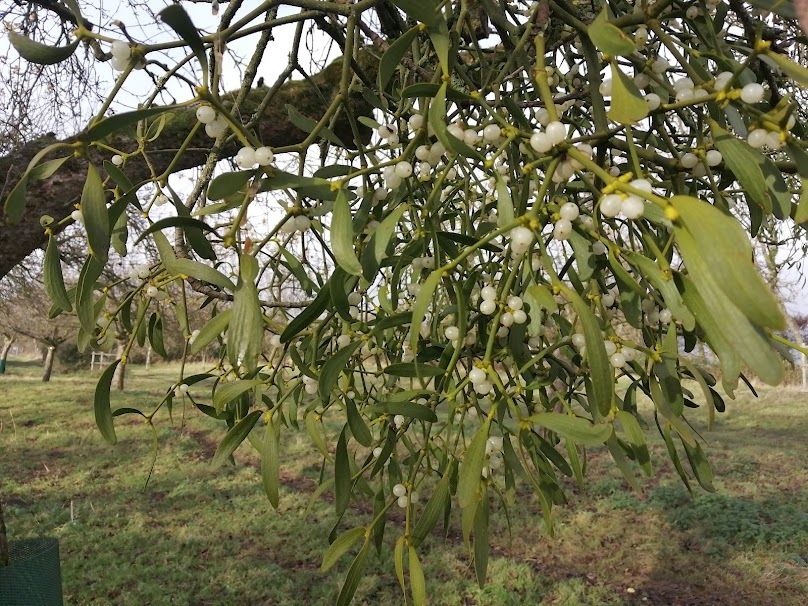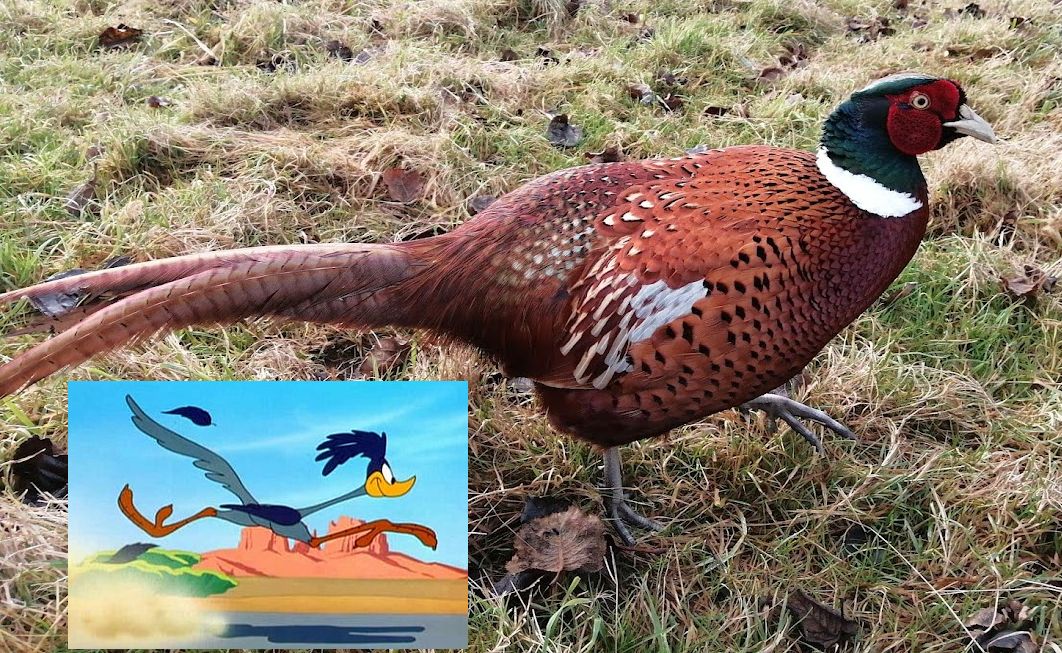With just a few days until October, we’re yet again at the start of the mistletoe season. So it is perhaps time for a quick review of how things are looking this time round:
As is fairly usual these days, there’s a reasonable crop of berries forming, so it could be another good year for quality mistletoe. This seems to be the norm, and indeed there is research that suggests berry numbers per branch don’t, often, change much from year to year.
 This might seem surprising – but, assuming pollination is successful, shouldn’t be when you consider how the plant grows. Each branch divides into two exactly once a year and each of those two new branches has identical terminal flower buds, every year. So there shouldn’t, logically, be much alteration in number of flowers, for any given section of branch, year on year, as the pattern and number of flower buds stays exactly the same. The main variant will be the amount of insect pollination of each flower in February/March and in the mild winters we get these days insect availability, for this essential role is, it seems, always sufficient.
This might seem surprising – but, assuming pollination is successful, shouldn’t be when you consider how the plant grows. Each branch divides into two exactly once a year and each of those two new branches has identical terminal flower buds, every year. So there shouldn’t, logically, be much alteration in number of flowers, for any given section of branch, year on year, as the pattern and number of flower buds stays exactly the same. The main variant will be the amount of insect pollination of each flower in February/March and in the mild winters we get these days insect availability, for this essential role is, it seems, always sufficient.
There are other variables in ‘quality’ of course such as the green-ness of the leaves (many plants are yellowy-green and of less value even with berries) and the legginess of the branches (compact short internodes seem more attractive) and whether male mistletoe (which never has berries) has been mixed in with the female.
All of this is relevant to mistletoe sales, the most well-known of which are the auctions at Tenbury Wells, cancelled last year because of the pandemic. There was, at that time, much talk of mistletoe shortages as a result, but my impression was the reality was different, and there was still plenty of mistletoe to be had. This does highlight the fact that, contrary to popular belief (especially in the media), the Tenbury auctions are not the only way to trade mistletoe! Indeed most of what’s seen in supermarkets and greengrocers may not be from Tenbury at all, and might not even be of British origin. Imports of mistletoe from mainland Europe have been significant since the late 19th century. It’s not all about Tenbury.
That last point might imply new and different trouble ahead – because the UK has left the EU trading bloc. Last autumn the UK was still in the ‘transition period’, not actually in the EU but still with freedom of trade. That ended in January 2021 and new rules on trade are now in place – or would be if the Government didn’t keep kicking them into the long grass rather than tackling the problem they’ve made.
For cut mistletoe, assuming it is classified as a cut flower, the rules are, at first sight, simple. Cut flowers originating in the EU have a zero-rated import tariff, so basic prices should not go up (though 8% tariffs were expected at one point in the discussions). That sounds good, but it’s not quite that simple, as there is still paperwork that wasn’t needed before – customs forms etc. This requires more work, adds more cost and reduces the attractiveness of the trade.
The paperwork might get very onerous if phytosanitary certification is needed. Leaving the EU means that the UK is now longer in the same phytosanitary area and imports and exports of plants or plant parts, may need such certification*. Indeed this was, and still is, the plan for cut flowers, with phytosanitary inspections due to have started last April. Happily, for this Christmas season at least, this isn’t yet needed, as the deadline for starting inspections of cut flowers has, like many other deadlines, been extended, in this case to January 2022.
So there will, in theory, be no major barrier for mistletoe imported from EU countries this season. But I wouldn’t be surprised if less is sent, as the rules, and the constant changing of dates, can be very confusing. This isn’t new, there were trading tariffs and restrictions on mistletoe at many times in the past 100-150 years, but there have been none in recent decades, none in living memory for most traders.
 Meanwhile, back at Tenbury Wells, business is, everyone hopes, back to normal this season. Auctions are planned for Tuesday 23rd November and Tuesday 30th November. Run, as usual, by Nick Champion: https://nickchampion.co.uk/auctions/holly-and-mistletoe/
Meanwhile, back at Tenbury Wells, business is, everyone hopes, back to normal this season. Auctions are planned for Tuesday 23rd November and Tuesday 30th November. Run, as usual, by Nick Champion: https://nickchampion.co.uk/auctions/holly-and-mistletoe/
 *PS The need for phytosanitary certification is definitely interfering with some aspects of the mistletoe trade. The Grow-Kits marketed by the English Mistletoe Shop for example, like most products sent as seeds for growing, can no longer be sent to the EU or even, at present, Northern Ireland, without individual inspection of each by a UK government inspector, with significant cost each time. There’s no suggestion that they would fail the inspection, but the additional time and cost involves simply makes the process non-viable.
*PS The need for phytosanitary certification is definitely interfering with some aspects of the mistletoe trade. The Grow-Kits marketed by the English Mistletoe Shop for example, like most products sent as seeds for growing, can no longer be sent to the EU or even, at present, Northern Ireland, without individual inspection of each by a UK government inspector, with significant cost each time. There’s no suggestion that they would fail the inspection, but the additional time and cost involves simply makes the process non-viable.
 Almost the end of January, so it will soon be mistletoe flowering season and, of course, mistletoe seed germination season. That’s one of the many odd things about mistletoe – it flowers and germinates in late winter, the season when most plants are merely beginning to plan such energetic activities.
Almost the end of January, so it will soon be mistletoe flowering season and, of course, mistletoe seed germination season. That’s one of the many odd things about mistletoe – it flowers and germinates in late winter, the season when most plants are merely beginning to plan such energetic activities.

 If you’re worried about Nargles in your mistletoe then you’ve probably been reading too much Harry Potter, for that’s the only world where they occur. If indeed they occur at all.
If you’re worried about Nargles in your mistletoe then you’ve probably been reading too much Harry Potter, for that’s the only world where they occur. If indeed they occur at all.







 The tip-jar
The tip-jar (new for 2021, not quite sure about this!)
(new for 2021, not quite sure about this!)


 The first of a few rather tasteless mistletoe-themed things for this season. Thankfully it’s too late to get this one – the Smooching Sweater – now, so there’s no need to worry. Unless someone managed to get you one for Christmas. Each sweater had to be won though – you couldn’t just buy one.
The first of a few rather tasteless mistletoe-themed things for this season. Thankfully it’s too late to get this one – the Smooching Sweater – now, so there’s no need to worry. Unless someone managed to get you one for Christmas. Each sweater had to be won though – you couldn’t just buy one. 






 Nicking the concept for Covid-19 variants, I wonder whether someone standing under mistletoe this December will be more, or less, attractive now that we have the Omicron variant.
Nicking the concept for Covid-19 variants, I wonder whether someone standing under mistletoe this December will be more, or less, attractive now that we have the Omicron variant.

 The first Mistletoe Auction of the year takes place tomorrow morning, which to many means the proper start of the mistletoe season.
The first Mistletoe Auction of the year takes place tomorrow morning, which to many means the proper start of the mistletoe season. The berries are already nice and white – and there’ll be more mistletoe news here soon.
The berries are already nice and white – and there’ll be more mistletoe news here soon. This might seem surprising – but, assuming pollination is successful, shouldn’t be when you consider how the plant grows. Each branch divides into two exactly once a year and each of those two new branches has identical terminal flower buds, every year. So there shouldn’t, logically, be much alteration in number of flowers, for any given section of branch, year on year, as the pattern and number of flower buds stays exactly the same. The main variant will be the amount of insect pollination of each flower in February/March and in the mild winters we get these days insect availability, for this essential role is, it seems, always sufficient.
This might seem surprising – but, assuming pollination is successful, shouldn’t be when you consider how the plant grows. Each branch divides into two exactly once a year and each of those two new branches has identical terminal flower buds, every year. So there shouldn’t, logically, be much alteration in number of flowers, for any given section of branch, year on year, as the pattern and number of flower buds stays exactly the same. The main variant will be the amount of insect pollination of each flower in February/March and in the mild winters we get these days insect availability, for this essential role is, it seems, always sufficient. Meanwhile, back at Tenbury Wells, business is, everyone hopes, back to normal this season. Auctions are planned for Tuesday 23rd November and Tuesday 30th November. Run, as usual, by Nick Champion:
Meanwhile, back at Tenbury Wells, business is, everyone hopes, back to normal this season. Auctions are planned for Tuesday 23rd November and Tuesday 30th November. Run, as usual, by Nick Champion:  *PS The need for phytosanitary certification is definitely interfering with some aspects of the mistletoe trade. The
*PS The need for phytosanitary certification is definitely interfering with some aspects of the mistletoe trade. The 









